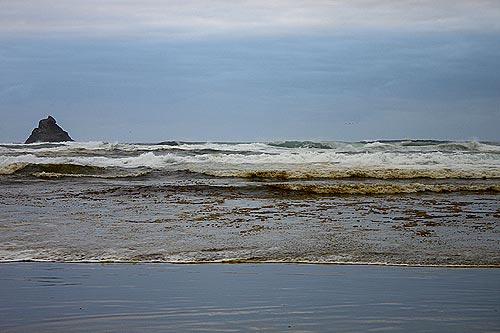 |
Oregon Coast Beaches Abound with Brown Bubbles, Other Wonders
Published 10/07/2011

(Oregon Coast) – It's beachcombing season again, and plenty is washing up along the Oregon coast to coax people into wandering the sands in search of funky treasures. On top of the wacky wonders washing up, the beaches of the north coast are again seeing tons puzzling brown bubbles and waves – which look like pollution to some, but it's actually a form phytoplankton (Above: Arch Cape on Thursday).
All of this is creating a spectacle of one kind or another, just in time for a three-day weekend where extra crowds are expected to hit the coast, as many will have Monday off.
Numerous lodgings along the coast are reporting extra heavy reservations.
 |
| Brown waves in Seaside |
In the Seaside and Cannon Beach area, including Arch Cape, lots of brown goo has been popping up. This often causes at least a few calls to officials – usually in Seaside – with visitors wondering if it's pollution. So far, there are only reports of this happening in these areas and not on the central coast.
It's actually a form of phytoplankton called diatoms, which are microscopic plant-like organisms that are part of the bottom of the food chain in the ocean. A combination of currents and extra nutrient-rich conditions in Clatsop County causes a higher than usual population of these critters, largely because of the outflow of the Columbia River.
In Arch Cape on Thursday, just south of Cannon Beach, several spots were thick with brown waves – others not. One area, about 40 feet wide along the beach, was especially thick and had an abundance of brown blobs and bubbles.
This was the case in Seaside as well.
Keith Chandler, manager of the Seaside Aquarium, said there had been a lot of the brown waves in recent days.
“There have been a lot of the diatoms,” he said. “This is good for clams, helping them grow.”
At least partially because of the extra diatoms in this area, the beaches of Clatsop County usually have the highest concentration of razor clams under the sand.

Above Tubeworms in Seaside, courtesy Seaside Aquarium
All along the coast, however, big waves and high surges have meant plenty of nifty stuff for beachcombers. Oregon Department of Fish and Wildlife has even reported some Japanese glass floats being spotted.
Among the oddities are what are called tubeworms. Tiffany Boothe of Seaside Aquarium found some bundles of them last week on the beach at Seaside. Indeed, they're common everywhere on the coast, such as Newport, Gleneden Beach, Oceanside, Pacific City, Rockaway or Florence – basically any beach or rocky area where stuff washes up.
“These large spaghetti-like things on the beach were tube worms,” Boothe said. “Strong waves knocked them off of the rocks they attached themselves to and cast them onto shore, where inevitably, they will be eaten by birds.”
 |
| Cannon Beach at night |
With their smooth, rounded tips that look a bit like heads, they are frequently mistaken for seals bobbing in the water, but they are still just attached to whatever rock they've affixed themselves to.
Also visible now, depending on the beach, is the glowing sand phenomenon at night. Extremely faint displays were found in Arch Cape late on Thursday night. They too are a form of phytoplankton, but these give off a glow when disturbed or touched.
Usually they need a fair amount of sunlight to “charge up,” and that has definitely been lacking on much of the coast lately. However, with large amounts of diatom blooms often come other kinds of phytoplankton, like the dinoflagellates, which are the bioluminescent kind.
You need an extremely dark beach with little or no light interference from any sources to those. More on finding those here.
More About Oregon Coast hotels, lodging.....
More About Oregon Coast Restaurants, Dining.....
 |
 |
 |
LATEST OREGON COAST NEWS STORIES
Whale Body Parts Found on Oregon Coast - Two Whales Strand on Washington Coast |
Back to Oregon Coast
Contact Advertise on BeachConnection.net
Secrets of the Season |
Unusual Travel Articles TravelParanormal.com allows you to submit your own creepy tale or debunk one - or see up-to-the-minute news headlines about travel and the paranormal. News Headlines from All Over Oregon Need to scan Oregon headlines? Constantly updated news from all over Oregon: a comprehensive, up-to-the-minute display of news headlines from a variety of media |




































